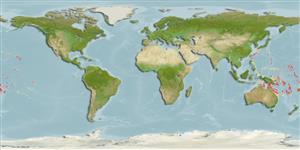>
Ovalentaria/misc (Various families in series Ovalentaria) >
Pomacentridae (Damselfishes) > Pomacentrinae
Etymology: Amphiprion: Greek, amphi = on both sides + Greek, prion, -onos = saw (Ref. 45335); pacificus: Named for its Pacific Ocean distribution..
Environment: milieu / climate zone / depth range / distribution range
Ecologia
marinhas associadas(os) a recifes; intervalo de profundidade 4 - 10 m (Ref. 85065). Tropical
Pacific: Wallis Island, Tonga, Fiji and American Samoa.
Tamanho / Peso / Idade
Maturity: Lm ? range ? - ? cm
Max length : 4.8 cm SL macho/indeterminado; (Ref. 85065)
Descrição suscinta
Chaves de identificação | Morfologia | Morfometria
Espinhos dorsais (total) : 9; Raios dorsais (total) : 18 - 20; Espinhos anais: 2; Raios anais : 12 - 13. This species is distinguished by the following set of characters: D IX,18-20; A II,12-13; pectoral rays 17-18; tubed lateral line scales 33-48; gill rakers 5-6 + 11-12; opercular spinules 8-11; body depth 2.2-2.6 in SL; color generally pinkish brown, usually grading to yellowish or orange on lower side of body including abdomen; white stripe on midline of snout extending posteriorly on forehead and along base of dorsal fin; fins whitish to semi-translucent (Ref. 85605).
This species is generally commensal with the anemone Heteractis magnificus (Quoy & Gaimard, 1833) at depths between about 4-10 m (Ref. 85065). Oviparous, distinct pairing during breeding (Ref. 205). Eggs are demersal and adhere to the substrate (Ref. 205). Males guard and aerate the eggs (Ref. 205).
Ciclo de vida ou comportamento de acasalamento
Maturities | Reprodução | Spawnings | Egg(s) | Fecundities | Larvas
Oviparous, distinct pairing during breeding (Ref. 205). Eggs are demersal and adhere to the substrate (Ref. 205). Males guard and aerate the eggs (Ref. 205).
Allen, G.R., J. Drew and D. Fenner, 2010. Amphiprion pacificus, a new species of anemonefish (Pomacentridae) from Fiji, Tonga, Samoa, and Wallis Island. aqua, Int. J. Ichthyol. 16(3):129-138. (Ref. 85065)
Status na Lista Vermelha da UICN (Ref. 130435)
Ameaça para os humanos
Harmless
Uso pelos humanos
Ferramentas
Relatórios especiais
Baixar XML
Fontes da internet
Estimates based on models
Preferred temperature (Ref.
123201): 25.2 - 29.4, mean 27.6 °C (based on 704 cells).
Índice de diversidade filogenética (Ref.
82804): PD
50 = 0.5000 [Uniqueness, from 0.5 = low to 2.0 = high].
Bayesian length-weight: a=0.01479 (0.00642 - 0.03409), b=3.00 (2.80 - 3.20), in cm total length, based on LWR estimates for this (Sub)family-body shape (Ref.
93245).
Nível Trófico (Ref.
69278): 2.8 ±0.3 se; based on size and trophs of closest relatives
Resiliência (Ref.
120179): Elevada, tempo mínimo de duplicação da população menor que 15 meses (Preliminary K or Fecundity.).
Fishing Vulnerability (Ref.
59153): Low vulnerability (10 of 100).
